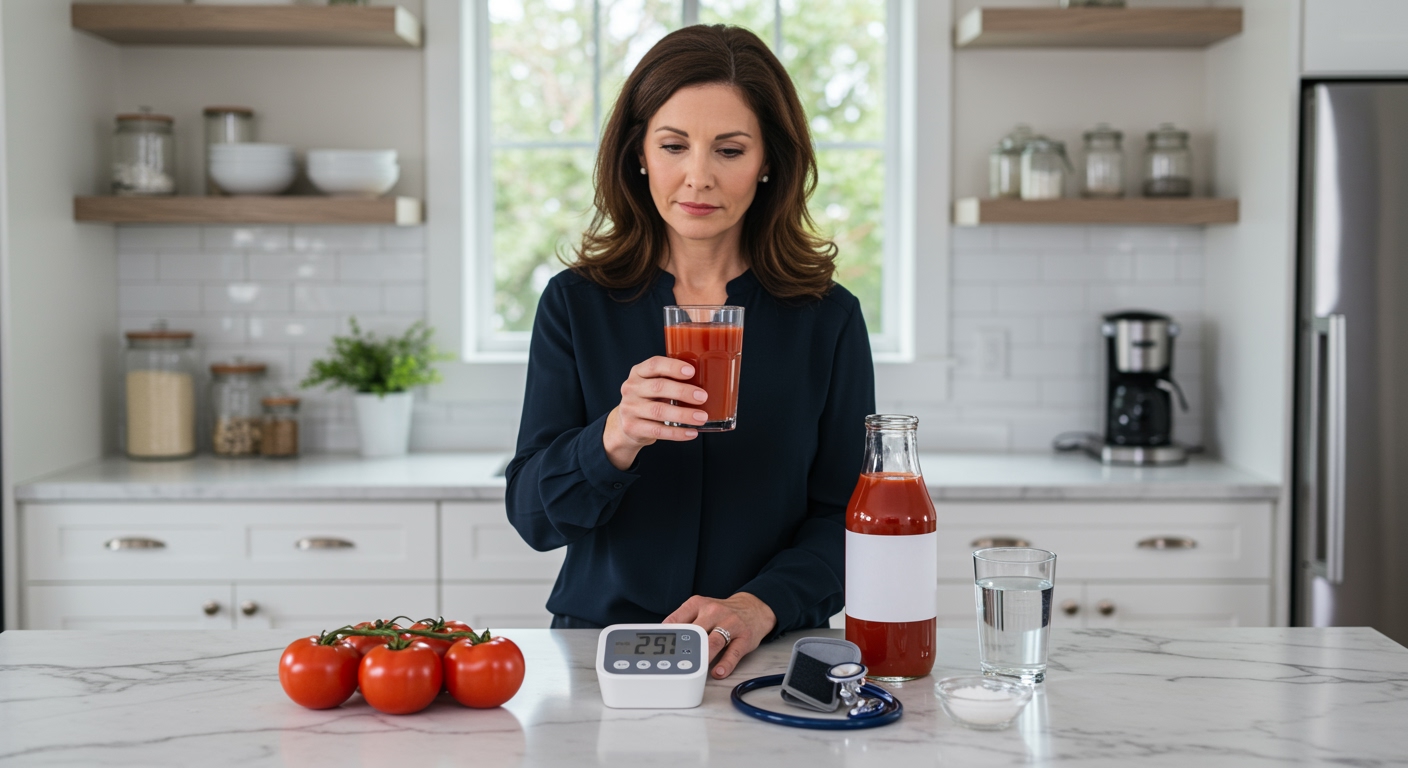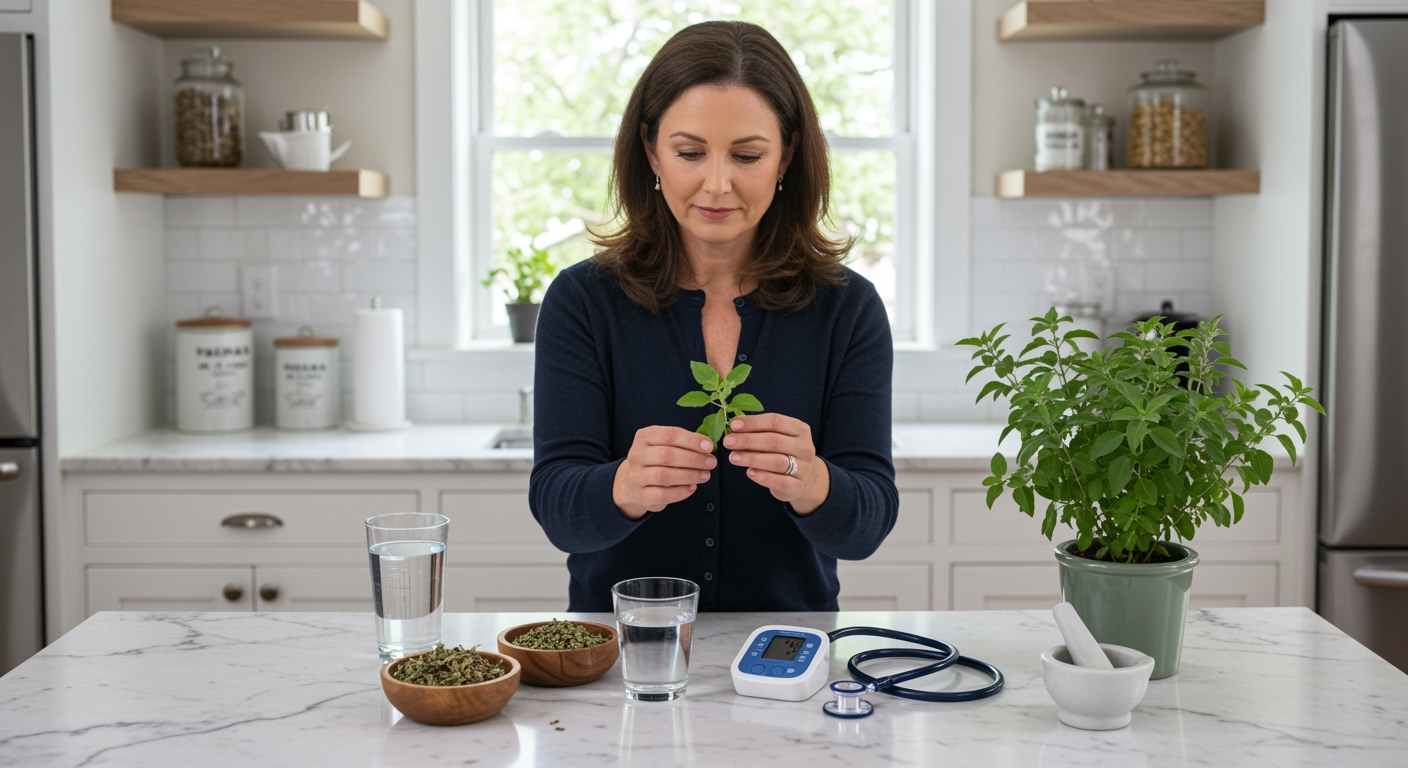✪ Key Takeaway: Tomato juice can help low blood pressure due to potassium content, but high sodium varieties may worsen the condition.
Introduction
Your doctor just told you that your blood pressure readings are consistently low, and now you are wondering if that glass of tomato juice in your fridge could be your solution.
Many people with low blood pressure search for natural ways to bring their numbers up to a healthier range, and tomato juice often appears on various health websites as a potential remedy.
Hi, I am Abdur, your nutrition coach, and today I am going to explain exactly how tomato juice affects your blood pressure and whether it can truly help your condition.
What Happens When You Drink Tomato Juice?
When you drink tomato juice, your body receives a complex mixture of nutrients that can influence your cardiovascular system in different ways.
The potassium in tomato juice acts as a natural vasodilator, which means it helps relax your blood vessel walls and can actually lower blood pressure rather than raise it.
However, many commercial tomato juices contain added sodium for flavor enhancement and preservation purposes.
This sodium content can cause your body to retain more water, which increases blood volume and potentially raises your blood pressure.
The lycopene in tomatoes also supports heart health by reducing inflammation in your blood vessels, but this effect typically takes weeks or months to become noticeable.
Your individual response to tomato juice will depend heavily on the specific product you choose and your current health status.
✪ Pro Tip: Always check the sodium content on tomato juice labels before purchasing to make an informed choice.
Does Sodium Content Matter For Low Blood Pressure?
The sodium content in tomato juice can actually be beneficial for people with low blood pressure, contrary to what most health advice suggests.
When you have low blood pressure, your body may benefit from moderate increases in sodium intake because sodium helps your kidneys retain more water.
This increased fluid retention raises your blood volume, which can help bring your blood pressure readings into a more normal range.
However, you need to be careful about the amount of sodium you consume because too much can cause uncomfortable swelling in your hands, feet, or face.
Most commercial tomato juices contain between 400-700 milligrams of sodium per cup, which represents about 20-30 percent of the daily recommended limit for healthy adults.
For people with low blood pressure, this sodium level might actually provide therapeutic benefits when consumed as part of a balanced approach to managing the condition.
Your doctor can help you determine whether increased sodium intake is appropriate for your specific situation and health history.
✪ Note: People with kidney disease should avoid high-sodium tomato juice without medical supervision.
Which Type Of Tomato Juice Works Best?
The type of tomato juice you choose makes a significant difference in how it affects your blood pressure levels.
Low-sodium or no-salt-added tomato juice varieties will not provide the sodium boost that people with low blood pressure might need to raise their readings.
Regular commercial tomato juice with added salt may be more beneficial for low blood pressure because it provides both the potassium from tomatoes and the sodium your body needs.
Fresh homemade tomato juice falls somewhere in between, offering natural potassium without added sodium, which may not significantly impact your blood pressure in either direction.
Vegetable juice blends that include tomato juice often contain even higher sodium levels and may provide more pronounced effects on blood pressure.
The concentration of the juice also matters because thicker, more concentrated products typically contain higher levels of both beneficial compounds and sodium.
Your best approach is to start with small amounts of regular tomato juice and monitor how your body responds over several days or weeks.
✪ Fact: One cup of regular tomato juice contains about 556 milligrams of potassium and 654 milligrams of sodium.
How Much Should You Drink Daily?
The appropriate amount of tomato juice for managing low blood pressure depends on your current health status and other dietary factors.
Most nutrition experts suggest starting with half a cup per day and gradually increasing to one full cup if you tolerate it well without side effects.
Drinking more than two cups daily may provide excessive sodium intake, even for people with low blood pressure who need more salt in their diet.
The timing of consumption can also influence effectiveness, with many people finding that drinking tomato juice with breakfast helps maintain steadier blood pressure throughout the morning hours.
You should spread your tomato juice consumption throughout the day rather than drinking large amounts all at once to avoid sudden spikes in blood volume.
Monitor your blood pressure regularly when adding tomato juice to your routine because individual responses can vary significantly based on genetics and overall health.
If you experience headaches, dizziness, or unusual swelling after increasing tomato juice intake, reduce the amount or consult with your healthcare provider about appropriate modifications.
✪ Pro Tip: Keep a blood pressure log when trying tomato juice to track your body’s response over time.
Are There Better Alternatives For Low Blood Pressure?
While tomato juice can be helpful, several other natural approaches may be more effective for managing low blood pressure.
Increasing your overall fluid intake with water throughout the day provides a more sustainable way to maintain adequate blood volume without relying on high-sodium beverages.
Eating smaller, more frequent meals can help prevent the blood pressure drops that often occur after large meals, especially those high in carbohydrates.
Compression stockings can help improve blood circulation in your legs and prevent blood from pooling, which naturally supports healthier blood pressure readings.
Regular physical activity, particularly exercises that strengthen your cardiovascular system, can help your body maintain more stable blood pressure over time.
Some people find that adding a small amount of sea salt to their regular meals provides the sodium boost they need without relying solely on processed beverages.
The most effective approach often combines multiple strategies rather than depending on any single food or drink to manage your condition.
✪ Note: Always work with your healthcare provider to develop a comprehensive plan for managing low blood pressure safely.
The Bottom Line
Tomato juice can be a helpful addition to your low blood pressure management strategy, particularly if you choose varieties with moderate sodium content and consume appropriate amounts daily.
The key to managing any health condition lies not in finding a magic solution, but in understanding how different foods work with your unique body chemistry.
I would love to hear about your experience with tomato juice and low blood pressure management, so please share your thoughts, questions, or personal results in the comments section below.
References
At NutritionCrown, we use quality and credible sources to ensure our content is accurate and trustworthy. Below are the sources referenced in creating this article:
- Medical News Today: Can eating more tomatoes daily help lower high blood pressure
- PMC: Tomato consumption and cardiovascular health
- Clinic Barcelona: Eating a tomato a day reduces the risk of high blood pressure
- Medical News Today: Morning drink for high blood pressure





